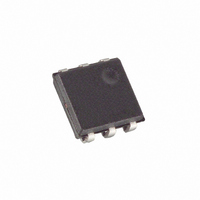DS2406P/T&R Maxim Integrated Products, DS2406P/T&R Datasheet - Page 19

DS2406P/T&R
Manufacturer Part Number
DS2406P/T&R
Description
IC SW DL ADDRESS W/1K MEM 6-TSOC
Manufacturer
Maxim Integrated Products
Datasheet
1.DS2406.pdf
(32 pages)
Specifications of DS2406P/T&R
Applications
Remote Control, Remote Metering
Interface
1-Wire
Voltage - Supply
2.8 V ~ 6 V
Package / Case
6-TSOC
Mounting Type
Surface Mount
Lead Free Status / RoHS Status
Contains lead / RoHS non-compliant
DS2406
INITIALIZATION
All transactions on the 1-Wire bus begin with an initialization sequence. The initialization sequence
consists of a reset pulse transmitted by the bus master followed by a presence pulse(s) transmitted by the
slave(s). The presence pulse lets the bus master know that the DS2406 is on the bus and is ready to
operate. For more details, see the “1-Wire Signaling” section.
ROM FUNCTION COMMANDS
Once the bus master has detected a presence, it can issue one of the five ROM function commands that
the DS2406 supports. All ROM function commands are 8 bits long. A list of these commands follows
(refer to flowchart in Figure 13).
Read ROM [33h]
This command allows the bus master to read the DS2406’s 8-bit family code, unique 48-bit serial
number, and 8-bit CRC. This command should only be used only if there is a single slave on the bus. If
more than one slave is present on the bus, a data collision will occur when all slaves try to transmit at the
same time (open drain will produce a wired-AND result). The resultant family code and 48-bit serial
number will be invalid.
Match ROM [55h]
The match ROM command, followed by a 64-bit ROM sequence, allows the bus master to address a
specific DS2406 on a multidrop bus. Only the DS2406 that exactly matches the 64-bit ROM sequence
will respond to the subsequent memory function command. All slaves that do not match the 64-bit ROM
sequence will wait for a reset pulse. This command can be used with a single or multiple devices on the
bus.
Search ROM [F0h]
When a system is initially brought up, the bus master might not know the number of devices on the
1-Wire bus or their 64-bit ROM codes. The Search ROM command allows the bus master to use a
process of elimination to identify the 64-bit ROM codes of all slave devices on the bus. The search ROM
process is the repetition of a simple 3-step routine: read a bit, read the complement of the bit, then write
the desired value of that bit. The bus master performs this 3-step routine on each bit of the ROM. After
one complete pass, the bus master knows the 64-bit ROM code of one device. Additional passes will
identify the ROM codes of the remaining devices. See Application Note 187 for a comprehensive
discussion of a search ROM, including an actual example.
Skip ROM [CCh]
This command can save time in a single drop bus system by allowing the bus master to access the
memory and channel access functions without providing the 64-bit ROM code. If more than one slave is
present on the bus and, for example, a read command is issued following the Skip ROM command, data
collision will occur on the bus as multiple slaves transmit simultaneously (open drain pull-downs will
produce a wired-AND result).
19 of 32














